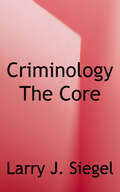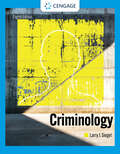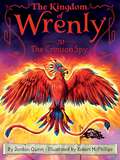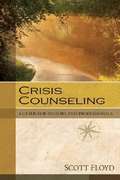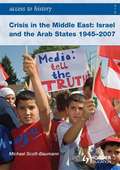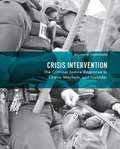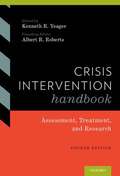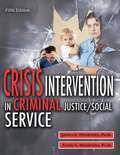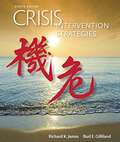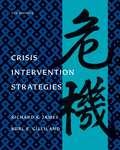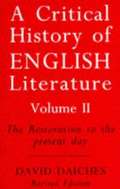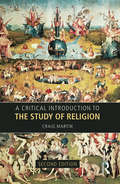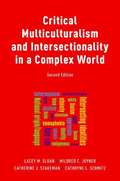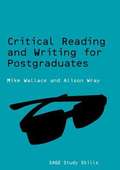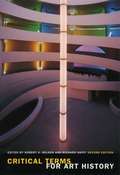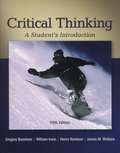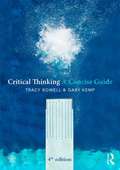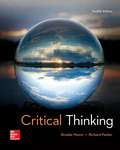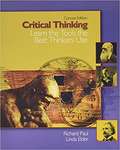- Table View
- List View
Criminology: Theories, Patterns and Typologies
by Larry J. SiegelThe bestselling text on the market and now in its thirteenth edition, CRIMINOLOGY: THEORIES, PATTERNS, AND TYPOLOGIES, delivers the most comprehensive, in-depth analysis of criminological theory and crime typologies available -- showing you how criminology relates to criminal justice policy. Renowned for his unbiased presentation of theories, issues, and controversies, Dr. Siegel encourages you to weigh the evidence and form your own conclusions. The text includes cutting-edge seminal research, up-to-the-minute policy, hundreds of new references, and new material on the legalization of marijuana, ISIL and terrorism, mass shootings, cybercrime, green crime, and transnational crime. It also maximizes your study efforts through chapter objectives, end-of-chapter reviews, key concepts, concepts summary tables, and newsworthy examples that help you see how what you are learning applies in the real world, thereby equipping you with the tools you need to succeed.
Criminology: The Core
by Larry J. SiegelThis book delivers cutting-edge coverage in a succinct, easy-reading paperback. Author Larry Siegel guides you through the fast-paced field of criminology, its most current research, and fascinating examples that help you truly understand criminological theory. <p><p>The text details the crimes of real-life people to illustrate specific criminology theories. Highlighting the interdisciplinary nature of the field, it also offers unbiased coverage of even the most controversial issues -- enabling you to form your own opinions. <p><p>This edition includes the latest insights into political crime; terrorism (e.g. ISIS, lone wolves); white-collar, blue-collar, and green-collar crime; cyber crime; transnational crime (e.g. sex trafficking); and many other topics. In addition, the text is packed with resources like "Thinking Like a Criminologist" role-plays and "Connections" to the big picture to help you maximize your course success.
Criminology
by Larry J. SiegelWritten by bestselling author Larry Siegel, CRIMINOLOGY, 8th Edition, guides you through the fast-paced field of modern criminology, its most current research and fascinating examples that help you understand criminological theory. Details on the crimes of real-life people illustrate concepts, while unbiased coverage of even the most controversial topics -- ranging from responses to sexual assault on campus to cybercrime -- enables you to form your own opinions about current issues and events. The 8th edition offers insights into racial bias, political crime, terrorism, green-collar crime, ransomware attacks, human trafficking, the impact of the COVID-19 pandemic and more. Features such as "Crime of the Century" provide in-depth discussions of notorious crimes that captivated the public and shaped the way we view the true meaning of justice. Also available: MindTap digital learning solution.
The Crimson Spy (The Kingdom of Wrenly #20)
by Jordan QuinnPrince Lucas and Lady Clara wonder who they can trust in this twentieth fantastical adventure of The Kingdom of Wrenly series!Danger washes ashore in the port of Silvertown, where a missing royal ship brings rumors of pirates. Not only that, but Prince Lucas and Lady Clara are tasked with caring for a rare gift: a phoenix. At first, they think nothing of the shimmering fire bird. But soon, they learn that not all magical creatures are to be trusted. With easy-to-read text and illustrations on almost every page, The Kingdom of Wrenly chapter books are perfect for beginning readers.
Crisis at McKinnon's Knob (Fountas & Pinnell Classroom, Guided Reading)
by Jennifer Gillis Alexander WellsNIMAC-sourced textbook. A BAD SITUATION. When two brothers find themselves in a dangerous situation while hiking, they call on survival skills they'd learned and hope those skills will be enough to save them.
Crisis Counseling: A Guide for Pastors and Professionals
by Scott FloydDr. Floyd helps readers understand the nature of crises events, how individuals are impacted, and how to best provide help during and following times of trauma, loss, and grief.
Crisis en la montaña (¡Arriba la Lectura!, Level P #23)
by Diana Noonan Trish BowlesNIMAC-sourced textbook
Crisis in the Middle East: Israel and the Arab States, 1945-2007 (Access to History)
by Michael Scott-BaumannThis book explores and analyzes the history of conflict in the Middle East from British rule in the early twentieth century to the Iraq war in the twenty-first century. The Arab-Israeli conflict is the main focus of this book but it also examines: Arab nationalism, especially in Egypt andSyria; the Islamic revolution in Iran in 1979; the causes and consequences of three wars involving Iraq; the growth of political Islam and Islamic fundamentalism in the Middle East. Throughout the book, key dates, terms and issues are highlighted, and historical interpretations of key debates are outlined. Summary diagrams are included to consolidate knowledge and understanding of the period, and exam-style questions and tips written by examiners provide the opportunity todevelop exam skills.
Crisis Intervention: The Criminal Justice Response to Chaos, Mayhem, and Disorder
by William M. Harmening Douglas CraigCrisis Intervention: The Criminal Justice Response to Chaos, Mayhem, and Disorder introduces readers to the methods and techniques of crisis intervention employed by police and correctional officers. Rather than focusing on abstract theories, this text presents real-life situations first and then explores the theories and methods relevant to those situations. It goes beyond the simple presentation of facts and incorporates best practices of policing and other topics usually found only in police training manuals. The text also examines the psychological effects of crisis on criminal justice professionals and ethical considerations related to crisis response.
Crisis Intervention Handbook: Assessment, Treatment, and Research (Fourth Edition)
by Kenneth Yeager Albert RobertsFewer concepts in American society have received more attention recently than the need for skilled crisis intervention. Images of crises inundate internet and newspaper headlines, television screens and mobile devices. As a result of the growing amount of acute crisis events portrayed in the media that impact the lives of the general public, interest in crisis intervention, response teams, management, and stabilization has grown tremendously. Skills and methods to effectively manage acute crisis situations are in high demand. While many claim to understand the rapidly growing demand for effective crisis management, few provide clearly outlined step-by-step processes to educate and guide health and mental health professionals. This is a thorough revision of the first complete and authoritative handbook that prepares the crisis counselor for rapid assessment and timely crisis intervention in the 21st century.
Crisis Intervention In Criminal Justice/Social Service (Fifth Edition)
by James E. Hendricks Cindy S. HendricksThis expanded new edition continues to demonstrate and provide theoretical, analytical, and practical knowledge for first responders. Face-to-face interaction with the client/victim is part of the comprehensive approach advocated by the book, which requires interveners to assess the nature of a crisis and the condition of the victim in order to determine the appropriate course of action. The comprehensive balance of theory and practice presented in this book should enable the intervener in coupling his/her general knowledge of human psychology and emotional crisis with the specific and novel characteristics of various crisis situations. The text represents the work of national scholars who have expertise in criminal justice and social service issues. Their chapters focus on a Historical and Theoretical Overview, Ethics in Crisis Intervention Practice, Intimate Partner Violence, Police Response to Domestic Violence, Children in Crisis, Elder Mistreatment, Suicide, Crisis of Rape and Survivor Intervention, Death Notification and the Theory and Practice of Delivering Bad News, Terrorism and Crisis Intervention, and Mass Casualty Crisis Response and Communication. Helpful appendices in each chapter provide additional internet resources, as well as a complete Model Law Enforcement Code of Ethics and Social Work Code of Ethics. This new edition retains important information while providing current case studies such as the "Miracle on the Hudson River" crash, the mass shootings at Virginia Tech, the Boston Marathon bombing, and the Yarnell Hill fire in Arizona. This exceptional book is designed for firefighters, police officers, community service officers, correctional workers, emergency medical workers, probation/parole officers, protective service workers, psychological counselors, social workers, and victim assistance workers among others.
Crisis Intervention Strategies
by Richard James Burl GillilandThis authoritative, best-selling text presents the latest skills and techniques for handling crisis situations. <p><p>The authors' task model clearly illustrates and elucidates the process of dealing with people in crisis, from defining the problem to obtaining commitment. Using this model, the authors build specific strategies for handling a myriad of different crisis situations, accompanied in many cases with the dialogue that a practitioner might use when working with the individual in crisis. This book puts you on the front lines with the crisis worker throughout the chapters, and then illuminates the techniques and strategies the worker used. <p><p>New videos in MindTap (available with the text) correlate with the text and demonstrate crisis intervention techniques, ensuring that you not only understand the theoretical underpinnings of crisis intervention theories, but also know how to apply them in crisis situations.
Crisis Intervention Strategies 7th Edition
by Richard K. James Burl E. GillilandThis authoritative, best-selling text presents the latest skills and techniques for handling real crisis situations. The authors' six-step model clearly illustrates and elucidates the process of dealing with people in crisis: Defining the Problem, Ensuring Client Safety, Providing Support, Examining Alternatives, Making Plans, and Obtaining Commitment. Using this model, the authors then build specific strategies for handling a myriad of different crisis situations, accompanied in many cases with the dialogue that a practitioner might use when working with the individual in crisis.
Crisis on the Mountain (Into Reading, Level T #23)
by Diana Noonan Trish BowlesNIMAC-sourced textbook
A Critical History of English Literature: The Restoration to the present day - Volume-2
by David Daiches"A Critical History of English Literature: The Restoration to the Present Day Volume-II" by David Daiches offers a comprehensive exploration of English literature from the Restoration period to the contemporary era. Daiches critically analyzes the evolution of literary trends, genres, and individual works during this expansive time frame. The book delves into the societal, cultural, and political contexts that influenced literary production, providing readers with a nuanced understanding of the dynamic relationship between literature and the changing landscapes of British history. Daiches skillfully navigates through major movements, key authors, and seminal works, offering insightful interpretations and evaluations. The volume serves as an invaluable resource for students, scholars, and enthusiasts seeking a deeper appreciation and critical assessment of English literature from the Restoration period to the present day.
A Critical Introduction to the Study of Religion
by Craig Martin'A Critical Introduction to the Study of Religion' explains the key ideas and methods in the study of religion and demonstrates how they can be used. The aim is to provide students with a tool-kit of critical concepts for studying religious belief and behaviour. Throughout the discussion all ideas and methods are illustrated with clear case material.
Critical Issues in Clinical and Health Psychology
by Dr Poul RohlederThis textbook gives a clear and thought-provoking introduction to the critical issues related to health, illness and disability in clinical and health psychology. Challenging some of the preconceptions of ill-health of the biomedical approach, the book explores how health and illness is often shaped by factors such as culture, poverty, gender and sexuality, and examines how these influences impact on the experience and treatment of physical and mental illness as well as disability. Students are introduced to literature from disciplines other than psychology to provide multiple perspectives on these complex issues.<P><P> Critical Issues in Clinical and Health Psychology is a key textbook for undergraduate and postgraduate students taking courses in health or clinical psychology, as well as for students from other disciplines related to health and mental health care.
Critical Multiculturalism and Intersectionality in a Complex World
by Lacey M. Sloan Mildred C. Joyner Catherine J. Stakeman Cathryne L. SchmitzCritical Multiculturalism and Intersectionality in a Complex World guides the reader through a process of critical self-reflection that allows for examination of social identities, biases, and experiences of oppression and privilege. Its exploration of the history, sources, mechanisms, structures, and current manifestations of oppression ― complimented by case examples (with new stories from across the globe) and guiding questions ― provides a framework for improving the ability to recognize, confront, and dismantle oppressions. Deeper cultural patterns, implicit biases, and internalized negative perceptions are examined, enabling readers to explore cultures that have different patterns, values, and behaviors while challenging their own biases about 'other' cultures. In addition to a focus on the USA, this edition features added content on Brazil, United Arab Emirates, Canada, South Africa, Australia, India, and Kenya. This new edition will appeal to all graduate and undergraduate students of the social sciences, human sciences, and humanities.
Critical Reading and Writing for Postgraduates
by Mike Wallace Alison Wray'A systematic, coherent approach to developing critical reading and writing skills that are applicable to a range of different levels of analysis and types of reading and writing tasks. The authors are to be commended for the clarity of their writing and the way scaffolded advice and tasks are integrated into the text. The book could form the core text for a course on critical reading and writing and a useful reference tool for the academic recently entered upon writing for publication.' - Educate Journal 'A very clear, accessible introduction that will be invaluable to postgraduate students trying to engage with reading and writing in a critical way' - R.M. Lee, Professor of Social Research Methods, Royal Holloway University of London This guide to critical reading and self-critical writing is a 'must-have' resource for postgraduate students and early-career academics. Packed with tools for analysing texts and structuring critical reviews, and incorporating exercises and worked examples drawn from the social sciences, the book offers step-by-step advice on how to: " read any text critically and analyse it in the depth appropriate to one's project " develop a self-critical approach to one's own academic writing " ask questions in order to evaluate authors' arguments " keep a review manageable by using focused review questions " structure a comparative review of multiple texts " build up a convincing argument " integrate critical literature reviews into a dissertation or thesis " make the transition from postgraduate to professional academic writer Essential reading for novice researchers, the book will also be invaluable for supervisors, methods course tutors, and academic mentors who teach and support the development of critical reading and self-critical writing skills.
Critical Terms for Art History (2nd edition)
by Robert S. Nelson Richard Shiff"Art" has always been contested terrain, whether the object in question is a medieval tapestry or Duchamp's Fountain.
Critical Thinking: A Student's Introduction (Fifth Edition)
by Gregory Bassham William Irwin Henry Nardone James WallaceBassham's popular text helps today's students bridge the gap between everyday culture and critical thinking. Using a proven step-by-step approach, this text covers all the basics of critical thinking in clear, reader-friendly language. The 5th edition has taken into account suggestions from users and reviewers of previous editions, and has added an Appendix, and new readings, exercises and examples throughout the text.
Critical Thinking: A Concise Guide (4th Edition)
by Tracy Bowell Gary KempWe are frequently confronted with arguments. Arguments are attempts to persuade us #65533; to influence our beliefs and actions #65533; by giving us reasons to believe this or that. Critical Thinking: A Concise Guide will equip students with the concepts and techniques used in the identification, analysis and assessment of arguments. Through precise and accessible discussion, this book provides the tools to become a successful critical thinker, one who can act and believe in accordance with good reasons, and who can articulate and make explicit those reasons. Key topics discussed include: core concepts in argumentation how language can serve to obscure or conceal the real content of arguments; how to distinguish argumentation from rhetoric how to avoid common confusions surrounding words such as #65533;truth#65533;, #65533;knowledge#65533; and #65533;opinion#65533; how to identify and evaluate the most common types of argument how to distinguish good reasoning from bad in terms of deductive validly and induction. This fourth edition has been revised and updated throughout, with a new introduction for each chapter and up-to-date topical examples. Particular revisions include: practical reasoning; understanding quantitative data, statistics, and the rhetoric used about them; scientific reasoning; the connection to formal logic and the logic of probability; conditionals; ambiguity; vagueness; slippery slope arguments; and arguments by analogy. The dynamic Routledge Critical Thinking companion website provides thoroughly updated resources for both instructors and students including new examples and case studies, flashcards, sample questions, practice questions and answers, student activities and a testbank of questions for use in the classroom.
Critical Thinking
by Richard Parker Brooke Noel MooreThe first integrated program designed specifically for the critical thinking course, Moore & Parker's Critical Thinking teaches students the skills they need in order to think for themselves--skills they will call upon in this course, in other college courses, and in the world that awaits. The authors' practical and accessible approach illustrates core concepts with concrete real-world examples, extensive practice exercises, and a thoughtful set of pedagogical features.
Critical Thinking: Tools for Taking Charge of Your Learning and Your Life (Third Edition)
by Richard Paul Linda ElderFor Student Success and Career Development, or Critical Thinking courses. Written by two of the leading experts in the field, this book's approach to critical thinking is as a process for taking charge of and responsibility for one’s thinking. Critical Thinking is based in theory developed over the last 30 years, it focuses on an integrated, comprehensive concept of critical thinking that is both substantive and practical; it fosters the development of basic intellectual skills students need to think through content in any class, subject, or discipline, as well as through any problem or issue they face. Simply stated, this text offers students the intellectual tools they need for lifelong learning, and rational, conscientious living. In this edition, several advanced chapters were eliminated, many diagrams have been added or enhanced, and the glossary of critical thinking terms has been more strongly developed.
Critical Thinking: Learn The Tools The Best Thinkers Use
by Richard Paul Linda ElderWritten by two of the leading experts in critical thinking, this book focuses on an integrated, universal concept of critical thinking that is both substantive and applicable to any and every situation in which human thinking is necessary. It provides readerse with the basic intellectual tools needed for life-long learning, helping them understand the mind and how its three functions — thinking, feeling, motivation — influence and are influenced by one another. This book fosters the development of fair-minded critical thinking. Features the intellectual standards: clarity, precision, accuracy, logicalness, significance, depth, breadth, and fairness; The importance of good questioning; and intellectual tools to read for deep and lasting comprehension, and to write in ways that show clarity of reasonability of thought. For all that want to improve their critical thinking skills to apply to their job or life.

